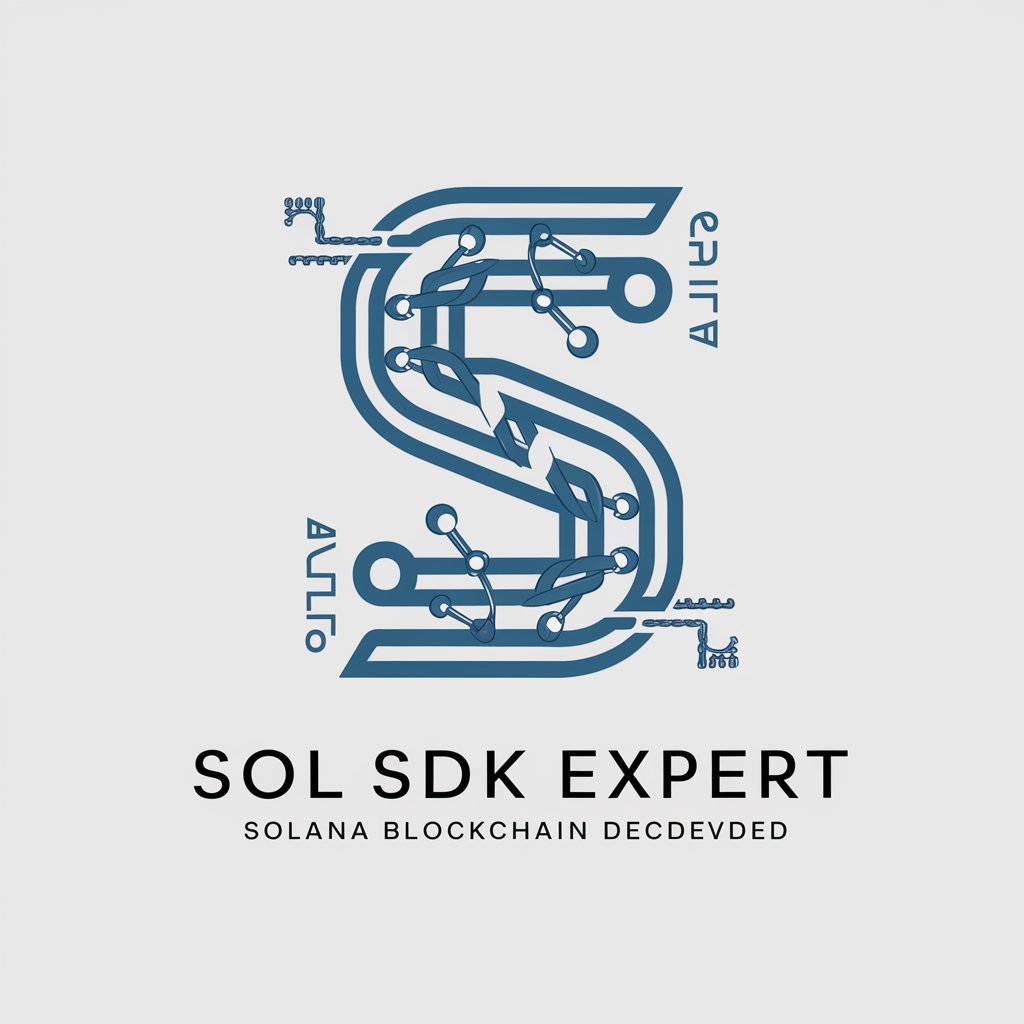
Solidity-Solidity smart contract generator
AI-powered Solidity contract builder

🟣 Advanced Solidity assistant and code generator with a focus on responsive, efficient, and scalable code. Write any smart contract and become a much faster developer.
✏️ Write a smart contract for decentralized voting
💰 Create a token swap feature with liquidity pools
🪲 Find any bug or improvement in my smart contract
💡 Teach me a useful skill or trick in Solidity
Get Embed Code
What is Solidity?
Solidity is a statically typed, contract-oriented programming language specifically designed for writing smart contracts on Ethereum and other EVM (Ethereum Virtual Machine)-compatible blockchains. Inspired by JavaScript, C++, and Python, Solidity provides a high-level syntax that allowsSolidity Functions and Users developers to implement complex decentralized logic on-chain. At its core, Solidity enables developers to encode rules, enforce trustless transactions, and create self-executing contracts with autonomy and immutability. For example, a Solidity smart contract can automatically release funds from an escrow once predefined conditions are met, eliminating intermediaries and reducing operational risks. Solidity's design purpose revolves around enabling decentralized finance (DeFi), non-fungible tokens (NFTs), DAOs (Decentralized Autonomous Organizations), and much more, with tamper-proof and trust-minimized code that lives on the blockchain.
Key Functions and Applications of Solidity
State Management with Persistent Storage
Example
contract Voting { mapping(address => bool) public hasVoted; function vote() public { require(!hasVoted[msg.sender]); hasVoted[msg.sender] = true; } }
Scenario
Used in a decentralized voting system toSolidity Overview and Functions track which addresses have already voted, ensuring that each address can vote only once. Storage is permanent and exists across transactions, maintaining the integrity of voting history.
Smart Contract Inheritance and Modularity
Example
contract Ownable { address public owner; modifier onlyOwner { require(msg.sender == owner); _; } } contract Token is Ownable { function mint() public onlyOwner { /* mint logic */ } }
Scenario
Useful in building upgradeable and modular systems. In this example, contract reusability allows access control to be handled in one base contract (`Ownable`), reducing duplication and improving maintainability across many contracts such as DeFi protocols and NFT platforms.
Event Emission and Blockchain Logging
Example
event FundsDeposited(address indexed user, uint256 amount); function deposit() public payable { emit FundsDeposited(msg.sender, msg.value); }
Scenario
Crucial for off-chain indexing and transparency. This is commonly used in dApps (decentralized apps) like decentralized exchanges, enabling frontend applications or oracles to react to blockchain activities by subscribing to these emitted events.
Who Should Use Solidity?
Blockchain Developers
Individuals or teams building decentralized applications (dApps), smart contracts, or blockchain protocols. These users benefit from Solidity's control over EVM behavior and its tight integration with Ethereum's tooling (e.g., Remix, Hardhat, Truffle). They are often tasked with deploying financial logic, NFT interactions, and DAO mechanics securely and efficiently.
Web2 Developers Transitioning to Web3
Experienced software engineers familiar with traditional web technologies who want to enter the decentralized ecosystem. Solidity's JavaScript-like syntax lowers the learning curve, allowing these developers to translate Web2 application logic into decentralized Web3 logic, enabling innovations like token economies and permissionless markets.
How to Use Solidity: A Practical GuideSolidity Usage and Guide in 5 Steps
Step 1
Visit aichatonline.org for a free trial without login, also no need for ChatGPT Plus. This lets you explore Solidity use cases, AI-powered code generation, and syntax help instantly.
Step 2
Install development tools like Remix IDE (web-based), or set up a local environment with Node.js, Truffle, Hardhat, and MetaMask. Remix is beginner-friendly and allows testing smart contracts in-browser.
Step 3
Write smart contracts in Solidity using proper versioning (e.g., `pragma solidity ^0.8.20;`). Start with simple patterns like token contracts (ERC-20/721) and escalate to custom logic as you grow familiar with data types, modifiers, and inheritance.
Step 4
Test your contracts extensively using built-in testing tools (Remix console, Truffle tests, or Hardhat with Mocha/Chai). Simulate blockchain interactions to verify logic, check for reentrancy, overflow, and access control issues.
Step 5
Deploy to a testnet (like Goerli or Sepolia) via MetaSolidity Usage GuideMask integration or CLI tools, and monitor the deployment using Etherscan. Use audit tools like Slither, MythX, or Code4rena for enhanced security before mainnet deployment.
Try other advanced and practical GPTs
Home Assistant
AI-powered smart home control assistant

NovelAI Copilot
AI-powered worldbuilding and storytelling companion

AI Shoes Finder by Picture
AI-powered shoe detection and recommendations

Cyber Security Expert
AI-Powered Cybersecurity Expertise, On-Demand

Lecture Study Notes
AI-Powered Tool for Smarter Study Notes

ㆍArduino Expertㆍ
AI-powered Arduino support from idea to execution

Marketing RRSS - Magenta Consultores
AI-powered social content for Mexican businesses

Nuxt
AI-powered Nuxt Framework Companion

最全数学建模赛题助手
AI-powered modeling solutions for every competition

数据分析大师 - 可生成中文图表
AI-powered data visualization with Chinese charting

Odoo Developer Assistant
AI-powered code help for Odoo developers

Med School Admissions Advisor
AI-powered help for med school admissions essays.

- Governance
- DeFi
- NFTs
- GameFi
- Tokenization
Top 5 Detailed Solidity Q&As
What is Solidity and why is it used?
Solidity is a high-level, statically typed programming language designed for writing smart contracts on the Ethereum Virtual Machine (EVM). It is primarily used to create decentralized applications (dApps), automate financial operations, manage NFTs, DAOs, and implement DeFi protocols. Its syntax resembles JavaScript and supports OOP principles, making it accessible to many developers.
How does Solidity handle inheritance and modular design?
Solidity supports single and multiple inheritance, enabling reusable modular design. Base contracts can be imported and extended using the `is` keyword. Functions from parent contracts can be overridden with `override` and `virtual` modifiers, facilitating clean abstraction and separation of concerns, especially in large-scale smart contract systems like token standards and governance frameworks.
What are the most common security pitfalls in Solidity?
Common security issues include reentrancy attacks, integer overflows/underflows (now mitigated by built-in overflow checks since Solidity 0.8.x), access control flaws, improper visibility of functions, and front-running vulnerabilities. To mitigate these, use the `checks-effects-interactions` pattern, SafeMath (if on older versions), access control libraries like OpenZeppelin’s `Ownable`, and run static analysis tools before deployment.
How does Solidity manage gas efficiency?
Solidity developers must optimize code for gas to reduce costs. Strategies include minimizing storage writes (expensive), favoring `memory` over `storage` when possible, using fixed-size data structures, packing tightly stored variables, and limiting loops. Solidity 0.8+ compilers provide optimizer flags (`--optimize`) to help minimize bytecode and execution costs.
Can Solidity interact with other blockchains or off-chain data?
Not directly. Solidity contracts operate within the EVM and cannot access off-chain data natively. However, decentralized oracles like Chainlink or UMA can be integrated to fetch external data securely (e.g., price feeds, weather, API results). For cross-chain interaction, bridge protocols or multi-chain frameworks (like Axelar or LayerZero) are used to facilitate interoperability.






